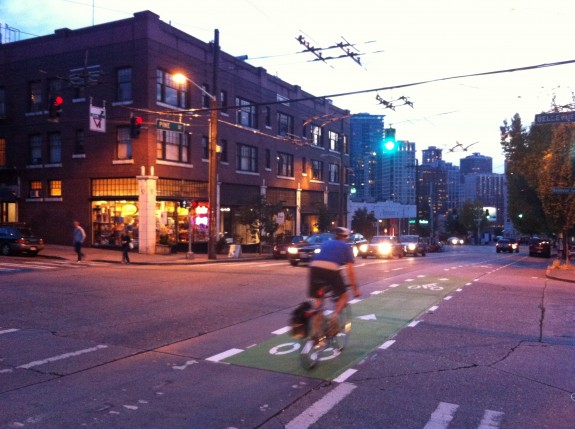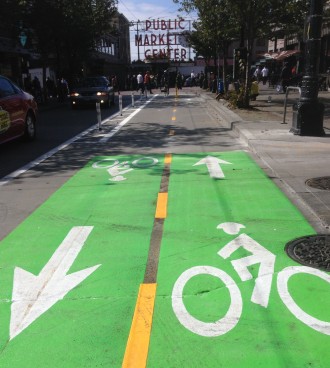

You don’t have to bike for very long in Seattle before you figure out the most dangerous kind of street: “Downhill streets with on-street parking and turning movements at intersections: Those are problems that Second Ave had,” Cascade Bicycle Club’s Advocacy Director Jeff Aken explained recently to Josh Cohen at Crosscut. “Cyclists get moving pretty good on those streets and without separation and visibility, it can be sketchy. You pay a heavy price for mistakes.”
And as the redesigned 2nd Ave bike lane shows us, it doesn’t need to be that way. These streets can be designed to be safer and more comfortable. That includes this list of familiar white knuckle bike routes Cohen found during his research:
From 2007 to August 2014, Second had 60 bike-car collisions and one fatality. But the city has many other problem spots. In that same period, Pine Street from 12th to First Avenue had 94 bike and car collisions. Roosevelt Way between 70th Street and the University Bridge had at least 63. There were 50 collisions [on Jackson] between 23rd Avenue in the Central District and First Avenue in Pioneer Square.
— Advertisement —
There are other problem spots, too: Rainier Avenue S.; the Ballard Bridge and the nearby “missing link” section of the Burke-Gilman Trail; the vexing five-way intersection under the West Seattle Bridge; Pike and Boren, among others.
The list could easily go on from there. But where once people seemed resigned to just throw their hands up in the air and give up, the success of 2nd Ave has shown that there is another way. And now we don’t need to fly to Copenhagen (or take the train to Vancouver) to see it for ourselves. It’s right in our own downtown.
The city is in the process of hiring a planning firm to handle design of the Center City Bike Network, which will move design on other needed bike lanes like 4th Ave, 7th Ave and some much-needed east-west corridors like Pike/Pine. Construction is currently planned for 2016 if all goes according to schedule. Though, as we have noted before, the city should look for opportunities to accelerate some of the most-needed connections, like on Pike Street.








Comments
9 responses to “Cohen: 2nd Ave protected bike lanes ‘just the beginning’”
You can bump that number on Roosevelt up to 64. I was in an unreported accident about a month ago. It was caused by a car stopped completely over the bike lane while waiting for a parking spot. I exited the bike lane to go around the stopped car but then the truck I got behind in the car lane almost immediately stopped short and I hit their tailgate.
I certainly regret not reporting it after the fact. I also refuse to use that bike lane between 45th and the bridge from now on.
Yup. Whenever people ignore a bike lane like it doesn’t exist, and ride in a car lane because it’s safer, you know the bike lane was designed poorly. I usually do the same.
Northbound, the wide turn from Eastlake onto campus parkway also makes me nervous. The extra-wide turn onto campus parkway feels asking for car-bike collisions.
New infrastructure is great but there needs to be enforcement of the rules around how automobile users act around it. The new No Turn On Red signs on 2nd are almost universally ignored by car drivers and it isn’t much better than it was before the makeover as a result.
I wonder if this “Turn left on left arrow ONLY” sign gets better compliance because it is more clear, or because of the threat of oncoming traffic: https://www.google.com/maps/@47.6431971,-122.3220911,3a,75y,105.26h,98.53t/data=!3m4!1e1!3m2!1sMvo7ivLXXh5XktyjTjf3LQ!2e0
I suspect the later, but perhaps people are still confused about the “no turn on red” signs because they get a green forward arrow.
This is more similar to places where right turns on red are banned due to visibility/angles for pedestrians (e.g. WB Pacific Pl. at Pacific St. in the U District before construction switched the road to a one-way). Compliance there is not great either.
They started with those on 2nd, be apparently drivers could not understand them, so they switched the signs to “no turn on red” .
So for your example, I’m sure it is the oncoming traffic if people are stopping. I wonder if they stop when there is no oncoming traffic?
Lets see, arrow points forward, must mean I can turn Left, right?
For a couple of days it looked the SPD was enforcing the signs/lights, if they no longer are and if drivers are in fact regularly ignoring the lights, then I’d imagine it is even worse than before as the bicycle lights would give a false sense of security, and the protected lane means no left turning motor vehicle will move to the left before turning (not that many did before)
“Turn left on left arrow ONLY” isn’t an approved sign, that’s why they switched to “NO Turn on Red.”
I haven’t used the 2nd Ave lanes at rush hour since the first week, but I have a view of them out my window at Marion, and during the day compliance seems pretty high now that folks are starting to get used to it. Typically only one or two a day will turn on red.
Is it that much worse at commute-times?
It seems a fair bit easier to tell which vehicles are going to ignore the red, too, compared to the old configuration.
Third is still faster and safer, in my opinion, though.
I have been riding on 2nd going north only around 6pm. So it is not super peak time and compliance has greatly improved since the first week and since the sign change to no turn on red. I can’t speak for the morning time or th 5pm rush hour. I notice that when the first person starts to surge forward for a moment then there seems to be that realization and they stop. I have looked behind me after passing through and they did not turn after I when through. During the first week most of the left turners were turning after I went through.